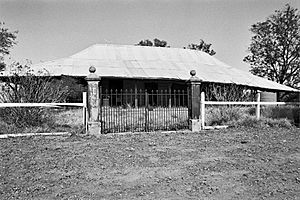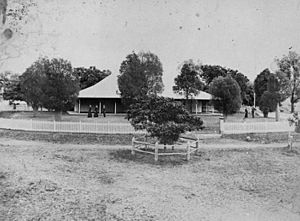Mount Abundance Homestead facts for kids
Quick facts for kids Mount Abundance Homestead |
|
|---|---|

Mount Abundance Homestead today
|
|
| Location | Warrego Highway, Bungil, Maranoa Region, Queensland, Australia |
| Design period | 1840s - 1860s (mid-19th century) |
| Built | c. 1860 - 1923 |
| Official name: Mount Abundance Homestead | |
| Type | state heritage (archaeological, built) |
| Designated | 21 October 1992 |
| Reference no. | 600371 |
| Significant period | 1860s (historical) 1860s-1880s (fabric) |
| Significant components | residential accommodation - main house, kitchen/kitchen house, causeway/ford, gate/s |
| Lua error in Module:Location_map at line 420: attempt to index field 'wikibase' (a nil value). | |
Mount Abundance Homestead is a very old and important house located near Roma in Queensland, Australia. It's called a homestead because it was the main house on a large farm or ranch. This historic building was mostly built around the 1860s. Today, it is protected as a heritage site because it shows us how Queensland developed a long time ago. It was officially added to the Queensland Heritage Register on October 21, 1992.
Contents
The Story of Mount Abundance Homestead
Early Days and First Settlers
The land where Mount Abundance Homestead stands was first claimed in 1847. A young man named Allan MacPherson from New South Wales took it over. He was looking for new places for his sheep to graze. MacPherson followed the path of an explorer, Sir Thomas Mitchell, who had named the area "Mount Abundance" in 1846.
Life was tough for MacPherson. He faced many challenges, including conflicts with the local Aboriginal people. Because of these difficulties, MacPherson decided the area was too dangerous. In 1849, he moved his sheep away and left Mount Abundance as a cattle station. He then returned to England.
In 1856, MacPherson came back to Australia for a short visit. During this time, he sold his land interests, including Mount Abundance. The new owner was Stephen Spencer.
Stephen Spencer's Time
Stephen Spencer and his family are thought to be the first European family to actually live and settle in the Mount Abundance area. When they arrived around 1857, the station was in poor condition. The buildings had even been damaged by fire.
The Spencers lived in rough temporary huts while Stephen built a new homestead. Mount Abundance station became a very important place for the whole district during this time. Stephen Spencer ran a supply store there. The station also served as a base for European explorers heading further west.
A post office was even opened at the homestead in September 1861. This shows how central the homestead was to the growing community.
Birth of Roma and Changes
In 1862, a surveyor named Augustus Charles Gregory visited Mount Abundance. He chose a spot nearby for a new town. This town became known as Roma, and it was officially declared in September of that year.
Once the Roma post office opened at the end of 1863, the post office at Mount Abundance Homestead closed. This marked a shift as the new town grew.
The Spencer family was also interested in farming. They grew the first wheat in the district. They also experimented with growing grapes, figs, peaches, and apricots.
New Owners and Growth
By late 1868, Stephen Spencer was in financial trouble. In 1869, the government sold the land where the homestead stood. It was bought by Robert Morehead and Matthew Young from Sydney. They represented a company called the Scottish Australian Investment Company. This company also bought the livestock in 1870.
The Scottish Australian Investment Company was a big investor in farms and ranches in Queensland from 1860 to 1890. They helped develop the pastoral industry.
Some records suggest that when the company took over Mount Abundance, the homestead was in bad shape. It's possible the company built a new homestead in the late 1860s, though this isn't certain.
By the mid-1870s, Mount Abundance station was considered one of the largest and best grazing properties in Western Queensland. The main station area included the homestead, a manager's house, an office, a store, and homes for other workers. There were also workshops and large storage buildings. The property even had a seven-acre garden.
A large woolshed near the homestead was said to be one of the biggest in Queensland in the early 1880s. Photos show that the homestead's original shingle roof was covered with iron between 1890 and 1895.
Government Takes Over
In 1923, the Queensland Government took back control of Mount Abundance station. They believed it was a good place to divide into smaller farms. The goal was to encourage more people to settle there and grow wheat and raise sheep.
The land was made available for selection in 1927. The Mount Abundance Homestead block, which was about 2018 acres, was chosen by Ernest Martyn. After he passed away, his son, P.J. Martyn, took over. The property was divided further in the late 1970s. Today, the homestead sits on an area of just under 500 hectares.
Of all the original buildings, only the main homestead and the quarters behind it still stand today.
What Mount Abundance Homestead Looks Like
Mount Abundance Homestead is located about 5 kilometers (3 miles) west of Roma. It sits on high ground next to the Bungeworgorai Creek. To reach it, you cross the creek using an old stone causeway.
The Main House
The main house is a single-story building. It has three main rooms facing north. A wide verandah (a covered porch) wraps around three sides of the house. Some parts of the verandah have been closed in to create extra rooms. The open parts of the verandah have pretty wooden decorations. The roof is a gently sloped hip roof, which means all sides slope down to the walls.
The house is built on strong timber logs that support the floor. The walls are made of timber with special overlapping boards called chamferboards on the outside. Inside, the walls and ceilings are made of wooden boards with a dark stain.
Two of the main rooms have fireplaces made of brick and stone. Six sets of French doors open from the main rooms onto the north verandah. One of these doors has been changed into a window.
The roof is covered with corrugated iron sheets. These were put over the original timber shingle roof. The iron roof extends out further than the old roof, supported by decorative brackets.
Other Buildings and Features
A covered walkway connects the main house to another single-story building. This building is set on low timber stumps and used to house quarters and a kitchen. It has an exposed timber frame and a steep gabled roof made of corrugated iron.
Not much of the original fencing remains. However, you can still see some original steps and mounting stones (used to help people get onto horses). The front entrance to the homestead has its original stone gate posts and iron gates. These gates have been moved from their first location. Large bottle trees stand on either side of this entrance.
Why Mount Abundance Homestead is Important
Mount Abundance Homestead was added to the Queensland Heritage Register in 1992 because it meets several important criteria:
- It shows how Queensland's history developed: The homestead is rare proof of how Western Queensland was settled and developed for farming and grazing from the 1850s onwards.
- It shows rare parts of Queensland's heritage: The homestead is one of the few remaining examples of early pastoral development in Western Queensland from the 1850s.
- It can teach us more about history: The site might hold archaeological clues about how buildings were constructed in the mid-1800s. It could also tell us more about the large station that once stood there, as only the homestead and attached quarters remain.
- It's linked to important people or groups: The Scottish Australian Investment Company played a big part in developing Queensland's grazing industry in the late 1800s. Their connection with Mount Abundance, which they made into a well-known grazing property, is very significant.


